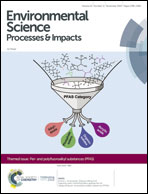Partition coefficients of four perfluoroalkyl acid alternatives between bovine serum albumin (BSA) and water in comparison to ten classical perfluoroalkyl acids†
Abstract
Perfluoroalkyl acids (PFAAs) are persistent, ubiquitous environmental contaminants and their long-chain representatives are bioaccumulative. The phase-out of these compounds (e.g. PFOA and PFOS) shifted the production to alternatives. However, little is known about the bioaccumulative behaviour of the alternatives, which are still highly fluorinated. PFAAs are predominantly detected in blood, where they bind to the transport protein serum albumin. This sorption can be described by the albumin/water partition coefficient. It is unclear whether the partition coefficients of the alternatives are lower than or in the same range as those of classical PFAAs. We determined albumin/water partition coefficients for seven perfluoroalkyl carboxylates, three perfluoroalkane sulfonates and four alternatives by dialysis experiments in a physiologically representative system. Quantification was done by LC-MS/MS and a mass balance approach. Logarithmic albumin/water partition coefficients for PFAAs range from 2.8 to 4.8 [Lwater kgalbumin−1] and increase with increasing chain length. Perfluorinated sulfonates sorb more strongly than their carboxylate counterparts. The albumin/water partition coefficients for the alternatives (HFPO-DA, DONA, 9Cl-PF3ONS and PFECHS) are in the same range as for classical PFAAs. Structural modifications such as the introduction of ether groups into the chain do not reduce sorption to albumin, whereas the chlorine atom in 9Cl-PF3ONS seems to even increase the sorption to albumin. We further investigated whether the sorption strength could be affected in the presence of medium- or long-chain fatty acids. Binding competition between medium-chain fatty acids and PFAAs appeared to be possible. However, the presence of physiologically more relevant long-chain fatty acids should not alter the albumin/water partition coefficients of PFAAs.

- This article is part of the themed collections: PFAS and Best Papers 2019 – Environmental Science: Processes & Impacts


 Please wait while we load your content...
Please wait while we load your content...